The Apple iPhone 6s and iPhone 6s Plus Review
by Ryan Smith & Joshua Ho on November 2, 2015 8:00 AM EST- Posted in
- Smartphones
- Apple
- Mobile
- SoCs
- iPhone 6s
- iPhone 6s Plus
Battery Life
With any smartphone, battery life is always one of the most important considerations. It probably goes without saying that more battery life is always better. In the case of the iPhone 6s, battery life is especially important to examine because this year Apple has actually made the battery of their phone smaller than before. Normally, it’s almost a given that battery size will be at least constant or increase but in order to accommodate additional components like the Taptic engine the battery has been made smaller. In light of this reversal one might assume that battery life has decreased as a result, but given the move to a FinFET process and other major component improvements it’s hard to say how battery life has increased or decreased. In order to test this properly, we ran the iPhone 6s’ through our suite of battery life tests to try and get an idea for overall battery life. As always, we run all battery life tests with the display set to an average of 200 nits and all possible background tasks disabled.
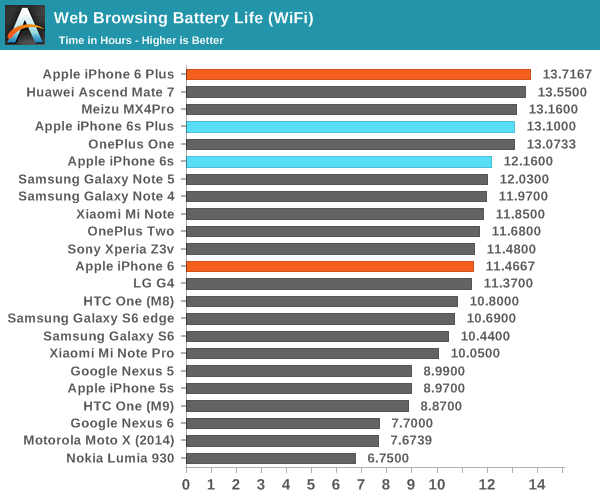
Our first test is WiFi web browsing, and here we see a pretty curious trend. The iPhone 6s Plus appears to regress relative to the iPhone 6 Plus, yet the iPhone 6s solidly beats the iPhone 6. I was pretty confused by this, but it’s likely that we’re seeing these results because the iPhone 6s is going to have larger relative power consumption of the SoC when compared to the display. As the display becomes bigger, the effects of SoC efficiency are just harder to notice, which also explains why it looks like the iPad Air 2 has effectively the same battery life whether you’re running just a blank display or our web browsing test. Both of our review units use a TSMC A9, so I don’t think we can attribute a foundry difference to the odd results that we’re seeing here.
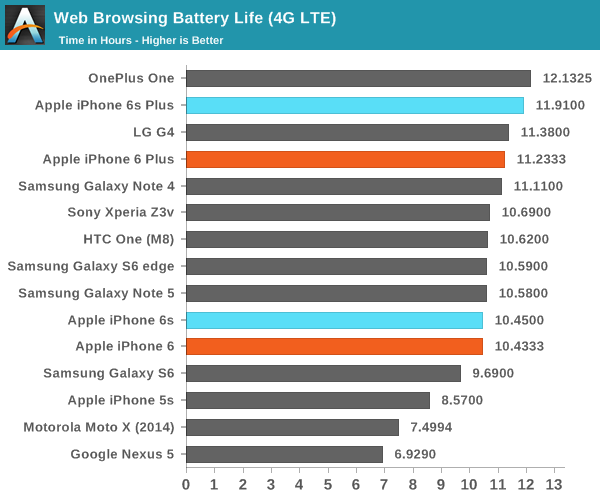
In LTE web browsing, we see a smaller improvement than what we observed in the WiFi test. This might seem strange, but given that the move from a 28nm process to a 20nm process on the modem from iPhone 6 to 6s didn’t come with FinFET it makes sense that the modem will remain a significant power drain. It’s likely that the next big jump in battery life here will come with FinFET process technology on the modem, along with other general modem design improvements.
In order to also look at battery life in more extreme scenarios, we use Basemark OS II and GFXBench to really place a strong stress on the CPU and GPU to see what power draw is like under sustained load. This also allows us to see the extent to which various components of the phone throttle down in response to relatively high sustained loads. However, it’s important to note that the Basemark OS II performance score here isn’t necessarily as accurate as scores from Android devices as the battery score can be calculated with 98 data points instead of 80 as battery score is partially derived from the rate at which the battery percentage decreases. It's also worth noting that in GFXBench there are two data points removed as the low power popup causes an incorrect frame rate to be recorded.
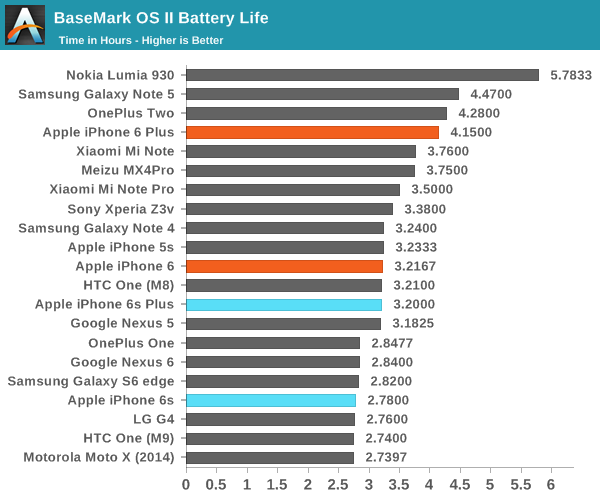
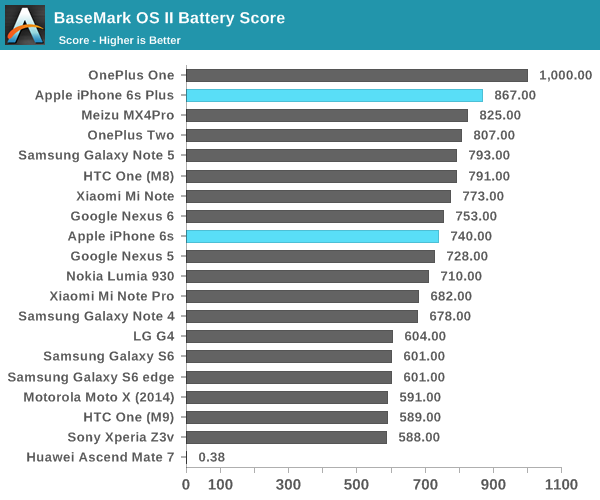
In Basemark OS II, we start off with a pretty shocking result as the iPhone 6s lasts less than three hours in this test, but looking at the battery score it’s pretty clear that the reason why the iPhone 6s doesn't last very long is because it’s running with relatively little throttling throughout the test, so the battery score is high as a result. The same is true of the iPhone 6s Plus, but the larger battery helps it to last a bit longer.
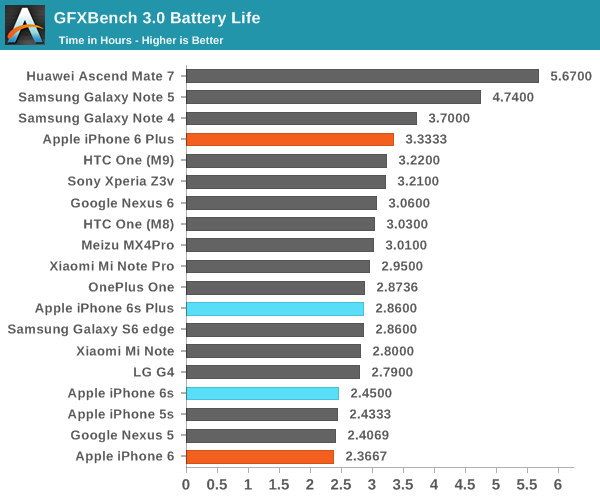
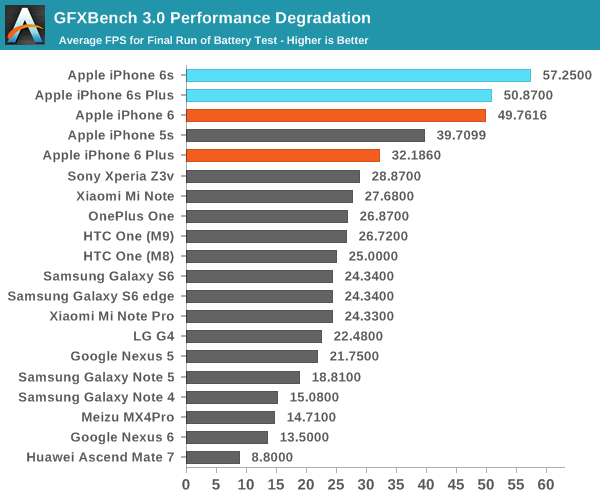
Looking at GFXBench, which is an infinite loop of the T-Rex on-screen benchmark to approximate intensive video gaming we see that the iPhone 6s doesn’t last very long either, but the performance throughout the test is incredible. Due to 1334x750 display resolution and strong GPU, the iPhone 6s manages to last the entire test without any notable throttling, and effectively pegged at the refresh rate of the display. The iPhone 6s Plus manages a similar level of performance but over time you can start to see some throttling, likely a function of the longer runtime and higher display resolution. It’s interesting to see how in the space of two years just how much progress has been made here in terms of improving GPU performance and efficiency, as when we first ran this test it was probably one of the most stressful tests out there for any smartphone or tablet.
Charge Time
Of course, while battery life is usually the main determinant of overall mobility it’s often important to consider charge time. A phone that charges slowly can be much less mobile than another phone, even if it has better battery life. In the case of the iPhone 6s’, it seems that Apple continues to ship the standard 5W charger that they have for many generations in the smartphone industry. In order to see how this charger and phone combination performs, we use our usual methods of timing the phone from fully discharged to fully charged.
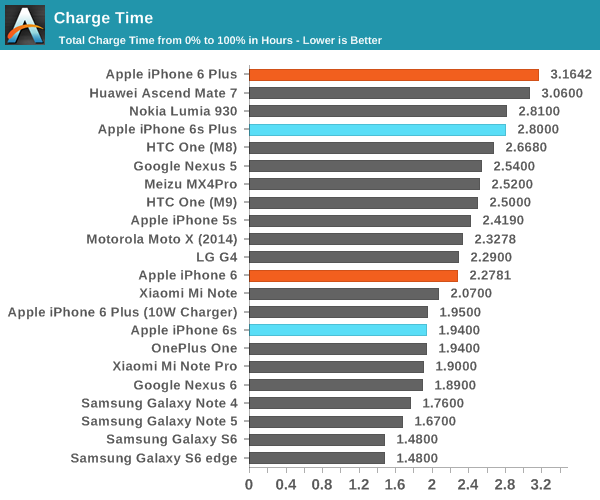
Here, the iPhone 6s and 6s Plus both show a decent improvement over the iPhone 6 and 6 Plus, but not enough to make an significant difference. The iPhone 6s charges at a pretty reasonable rate, but the iPhone 6s Plus really does need a more powerful charger than it does now. You can use an iPad charger to bring things back up to speed but getting this means that you either have to have an iPad already or you have to go out and buy an iPad charger, which is on the annoying side when Android OEMs generally include fast chargers in the box.




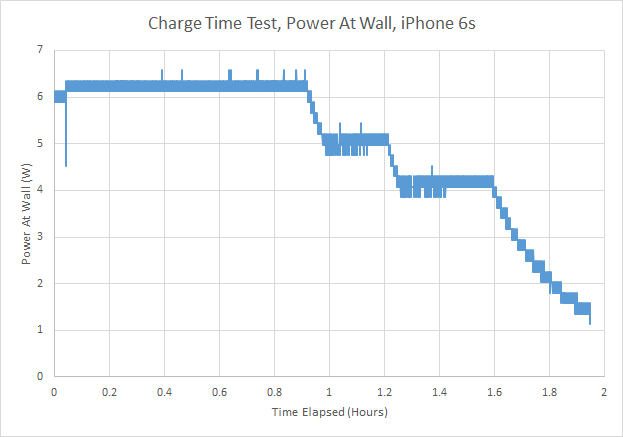
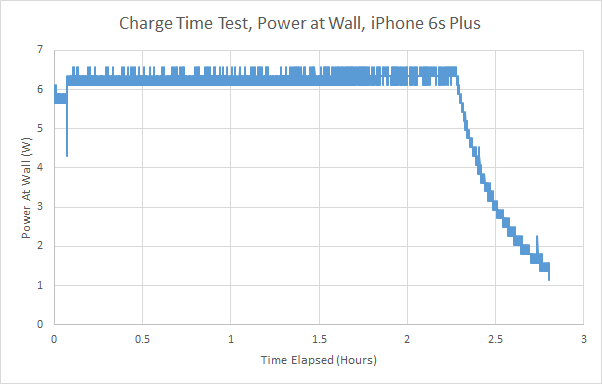








531 Comments
View All Comments
IanHagen - Wednesday, November 4, 2015 - link
I read on my phone all the time. It's great to have my library in my pocket and being relieved of carrying heavy books wherever I go.Caliko - Tuesday, November 3, 2015 - link
A higher resolution wouldn't make a difference(besides pleasing spec junkies).jospoortvliet - Wednesday, November 4, 2015 - link
Of course it would. Putting my HTC One m7 next to the latest iPhone shows the latter has simply less crisp text. The screen is awesome besides that but don't go and deny it has almost the same resolution as the cheap Moto G I bought for my wife... Just as it has taken Apple a long time to finally deliver a larger screen (though with a bang) and just as they keep sporting ridiculous bezels, the low resolution is both factual and a noticeable compromise. I suspect they just have a too rigid ecosystem of apps which is not build for responsive screen sizes, unlike Android.Of course it doesn't make the 6s any less amazing as a phone, it might not be the best on every aspect but it is very close and seems well deserving of the gold. Too bad it is an Apple product, closed off and locked down. The day I can just plug a normal USB cable in and it will present itself as a normal USB storage device to my OS (Linux), and I can replace all proprietary cloud services with my own, switch app store and use open source apps I might consider it. Until then - thanks but no thanks.
Caliko - Tuesday, November 3, 2015 - link
You're so full of it. The resolution is beyond what your eyes can distinguish.I can't believe in 2015 I STILL have to explain this. Feels like 2006 again....
Alexey291 - Tuesday, November 3, 2015 - link
Nope you're really really wrong. And yes in 2014 people even at apple realised that 330ppi is too little. They are just you know... Behind...lurker22 - Monday, November 2, 2015 - link
Or, it could be that the phone is really the best right now... maybe if android manufacturers would agree to stop abandoning their devices they would get more "bests." Something I noticed about android people, you're constantly whining whenever someone says the iPhone is a fantastic device.I have a Nexus 7, its ok, but wow is it not smooth or easy to maintain...i ended up installing a task manager to just get web browser to be somewhat less jerky on large pages.
SaolDan - Monday, November 2, 2015 - link
Come on dude. I dislike apple a lot but that being said they have very good hardware. Software sucks and a iPads i don't see a use for iPads specially the "pro" version specially when u can get a surface pro 4 for the same price but again their SOC are really really fast. im sayting this as someone who looks down on iPhones and iPad. I can respect mac os but IOS is garbage. BTW my work and only phone is a company issued iphone 6 so im not just saying all this. SP4 FTW.ASEdouardD - Monday, November 2, 2015 - link
I'd argue that since iOS 8, iOS is very close to Android in terms of functionality, and has the added value of a better App Store. To each his own of course, but I feel the gap between the two OS's is much smaller than it was before. Android's app store is better than it was, and you havec more functionality with iOS than before.SaolDan - Monday, November 2, 2015 - link
I lost my faith in android since 4.4. 4.3 was great. My wife got a lumia 1520 and that thing is awesome. Ive seen a few universal apps and they look great in big and small devices. I think that microsoft continuum would be great if it had a x86 SOC inside. I used to own a lumia 635 and i miss it so much.zeeBomb - Monday, November 2, 2015 - link
Soon ill get my hands on one.